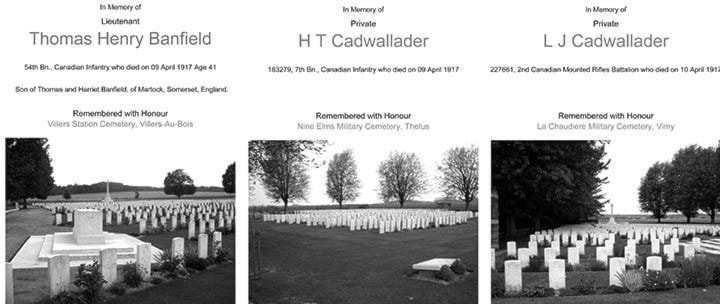Jim Cameron
The lodge members assembled at the Masonic Temple at 4 p.m. on Sunday, April 29, 1917. Dressed in full regalia and led by the Knights Templar they marched in solemn array from their meeting hall (the present day Studio on 11th Avenue) along Baker Street to 9th Avenue and onward to the former Presbyterian Church on the southeast corner of 9th Avenue and 1st Street.
There, they joined a large crowd gathered to honour the memory of Lieutenant Thomas Henry "Harry" Banfield, late of the 103rd Battalion of the Canadian Expeditionary Force, who died in action in France three weeks previously.
Harry Banfield, age 41, was well-known in Cranbrook. A partner in the contracting firm of Baker and Banfield, he not only contributed to the construction of numerous houses of Cranbrook following his arrival in the city in 1907, but was also a former alderman and a property owner of note.
He was older than many of the local WWI boys but by the time he enlisted in January, 1916, the army was willing to overlook age in order to fill their ever-decreasing numbers, especially as Harry had done well on his officer training course in the months prior to his enlistment.
Reverend W. H. Bridge: gave the sermon that day saying, in part "We have met to do honor to the memory of a fallen brother — one of a great host, one who held a place in our hearts and affections. We cannot but think of him first as a man, a son, a citizen, somebody's boy — and for the sake of these things, to uphold the honor of these things, a soldier."
He was indeed somebody's boy, the son of Thomas and Harriet Banfield of Somerset, England. One of five brothers and sisters, unmarried, five feet seven inches tall and weighing 134 pounds, Harry Banfield sailed from Halifax harbour on July 23, 1916, arriving in Liverpool, England, on the 31st. He joined his unit in France on March 31, 1917, and died nine days later on Vimy Ridge.
A letter of May 31, from Captain J.J. Martin, describes both his death and that of his good friend and former Cranbrook resident Major Bert Black as occurring while Lt. Banfield was moving his men back from a forward position raked by German machine gun fire. He was hit while covering the retreat.
A lad named Ashcroft from Vernon, B.C., attempted to dress hit wounds but it was too late. Ashcroft was fatally struck by a sniper soon afterwards. Major Black, wounded three times, died on April 12. Captain Martin stated "Black and Banfield are gone. They died fighting for home and liberty."
Lt. Banfield and Major Black were just two of the Cranbrook men who died during the battle for Vimy Ridge. It was a battle that saw, for the first time, the combined Canadian forces attack as one. It was notable victory, a victory said to have given birth to the unification of Canada as a country.
The source of great national pride undoubtedly, the birth of a unified country perhaps, but the wounding, maiming and death of over 10,000 Canadian soldiers. It was, in the grand scheme of things, just one of many battles in the big Allied push in that spring of 1917. The men who fought it had little idea of its import to their nation. They fought and died in a muddy, bloody morass of metallic thunder and man-made lightning. They, among the 3,598 Canadians killed during the battle, never knew the contribution they made. They died there, on Vimy Ridge and lay now among their slain comrades on the gentle, grassy fields that were once the very picture of Armageddon itself.
 Canadian soldiers consolidating their position at Vimy Ridge, April, 1917.
Canadian soldiers consolidating their position at Vimy Ridge, April, 1917.
Among the dead were other Cranbrook boys. For most their memorial services were not as grand as that of Lt. Banfield. By 1917, death had become commonplace. There are 166 names on the Cranbrook cenotaph; the city suffered, on average, one death every nine-and-a-half days over the course of the four years of the war. Cranbrook was a much smaller community then and by 1917, local services for the dead were a tragically common fact of life.
Among the others, Private Harold Cadwallader, age 23, and his younger brother Private Lawson Cadwallader, age 21, died within one day of each other. The sons of Welsh contractor Thomas Cadwallader and his wife Sarah, Harold worked for local dry goods merchant I. R. Manning before his enlistment in late 1915, while Lawson was a driver for the Cranbrook Trading Co. before he joined up in June 1916.
In a letter to the parents, the regiment's chaplain wrote that Lawson was killed instantaneously by a shell and that he died without suffering. It was a standard refrain in communications of the sort, perhaps it was the truth.
The Cadwalladers received the letter almost a month after his death. News was slow to travel from the battlefield to the hometown. Of his brother Harold there appears no indication of how he died save that he was killed in action. The Cadwallader family moved away shortly thereafter.
Lt. Harry Banfield, Privates Lawson Cadwallader and Private Harold Cadwallader are buried in separate cemeteries. They died at Vimy Ridge; they are buried in France, they live in the shadows of our town.
janusthenandnow@shaw.ca
